
Three new IMOCA 60s
Michel Desjoyeaux is just in the middle of laminating in the ballast tanks aboard his new IMOCA 60 Foncia when we speak to him. The resin is curing so he has time.
This is the third IMOCA 60 he has built. Previously there was PRB, with the the Finot hull and Lombard deck he built and won the 2000 Vendee Globe in, before Vincent Riou took it over and sailed it to victory in the 2004 race. For the last Vendee in 2008-9 Globe Desjoyeaux with his new sponsor Foncia sailed his Farr-designed IMOCA 60 to his second victory in the singlehanded non-stop round the world race.
For his latest boat Desjoyeaux chose VPLP, who previously designed his ORMA 60 trimaran Géant, and Guillaume Verdier. The VPLP-Verdier partnership penned Marc Guillemot’s Safran and Kito de Pavant’s Groupe Bel for the last Vendee Globe, Safran achieving success last year when she won the Transat Jacques Vabre. Despite not having the desired result in the last Vendee Globe, VPLP-Verdier are flavor of the month in the French IMOCA world and have three new Open 60 commissions, two of which have been launched this year in Vincent Riou’s latest PRB and Jean-Pierre Dick’s new Virbac-Paprec 3 and finally the new Foncia which is due for launch in the first week of September.
So why VPLP/Verdier, we put it to Desjoyeaux? “I wanted to be sure that I could be at the start of the Route du Rhum with a new boat. So while discussing with Vincent Lauriot Prevost he convinced me to make a different new boat instead of just making a new boat and today I can tell you he was right - because I think we have improved as a third generation design from them. I hope it will be a nice fast boat.”
Once again the boat has been built in Desjoyeaux’s native Port la Foret by CDK Composites, the chantier run by his elder brother Hubert. Desjoyeaux makes no secret of his love of technology and he is regularly on the shop floor taking part in the build.
At present the hull and deck are still separate but the main bulkhead is in and the deck is finished ready to be painted while the topsides will be painted next week. Deck and hull will then be joined.
As Desjoyeaux mentions the new Foncia, is a third generation VPLP-Verdier IMOCA 60. Vincent Riou’s new PRB was built from Safran’s moulds and was the first to be launched this year. She has the similar ORMA 60-style curved daggerboards Safran has, only they are longer. However unlike Safran she has a wingmast.
But the fundamental difference between the new VPLP-Verdier boats and the original two is that they must now conform to the new IMOCA 60 rule, designed to prevent costs spiralling upwards along with the power of the boats. For the designers, the principle differences are that there is now a righting moment limit to the boats (much the same as where the previous generation got to) and a new maximum mast height, roughly the median of where the last generation boats ended up. Other new stipulations are that transom-hung rudders have been outlawed, so new boats must have spade rudders mounted under the transom, although they can still kick-up.
So designers will presumably be aiming at maximum mast height and righting moment. In the case of the former this means that mast height of the new boats is actually less than that of Safran and Groupe Bel. So the VPLP-Verdier designs hope to achieve a performance gain over the older generation by going for minimum weight and a lowering of the centre of gravity with the end result being a lighter, slightly stiffer boats than what went before. Designer Vincent Lauriot Prevost reckons the new boats are on average around 200kg lighter than the old generation when they were first launched, although both Safran and Groupe Bel have since been optimised.
With PRB they went for a steel rather than a carbon fibre keel foil to lower the CoG, and a feature of all the new VPLP-Verdier designs is that the cockpit has moved forwards, closer to the centre of the boat (fore and aft) and cabintops have been pared right back.
With PRB the cabintop is narrow flaring out with a mini doghouse either side at the cockpit bulkhead. The MichDes C-shaped mainsheet track for the mainsheet and vang has been dispensed with in favour of a slightly curved conventional main sheet track and this is located further forward in the boat. Effectively this reduces the size of the cockpit. So we are seeing the trend back from the monster open cockpits and giant cruising yacht-style coachroofs of the last couple of generations of boats (the large cockroof originally designed to help the boats right from a full inversion as stipulated in the IMOCA 60 rule) towards smaller cockpits in the middle of the boat and smaller cabintops.
As Vincent Lauriot Prevost puts it: “The cockpit is more forward and there is a minimalist roof. The roof has an impact on the headroom and you have to accept that the headroom has been quite reduced in most parts of the interior on PRB. So I think the boat will be a lot less comfortable than the previous ones!”
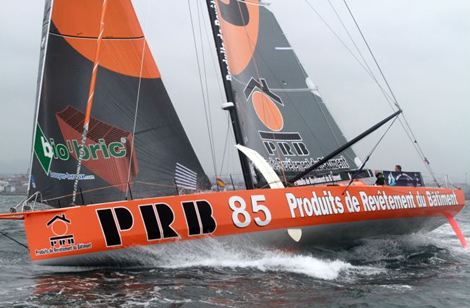
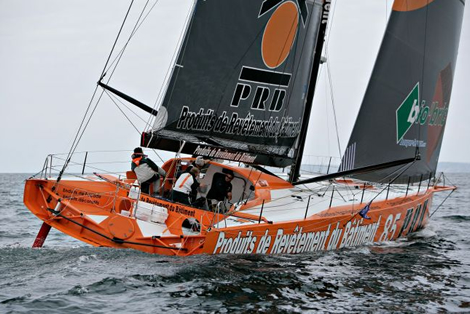
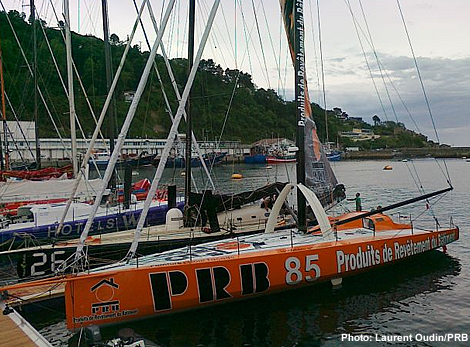
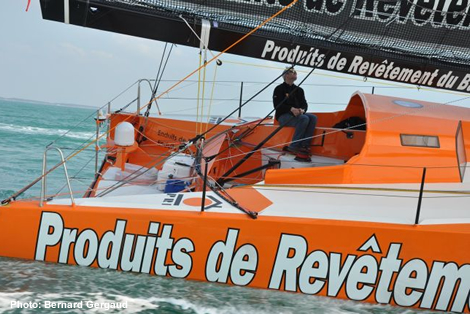
Another step back with PRB is with her deck spreaders. Recent Open 60s have seen the deck spreader attachment points moving further and further away from the mast - on to the coachroof and down on to the deck. However with PRB they have returned to pinning them to the mast step (where Yves Parlier put them when he installed deck spreaders for the first time on Aquitaine Innovations in the mid-1990s). According to Lauriot Prevost: “They are a bit longer and that gives you better angle, so you have less effort in the cables which hold it. And you don’t have the internal structure to transition the loads from the attachment in the deck to the main bulkhead, because everything is in one point. This solution is easier to build and maybe saves a bit of weight too.”
Jean-Pierre Dick’s third Paprec-Virbac was launched in May down in New Zealand following a build by Mick Cookson. This boat was a completely new design and according to Lauriot Prevost, Dick’s request was for a boat with less water ballast than his previous one -the 2008 Vendee Globe generation of IMOCA 60s carry a massive amount of water ballast, as much as 5 tonnes, in tanks throughout the boat, including mid-ships. The result is that Paprec-Virbac 3 has a slightly beamier hull shape, that is different to the first generation (we don’t think the chine extends all the way forwards) and a ‘different’ ballast configuration to achieve maximum righting moment.
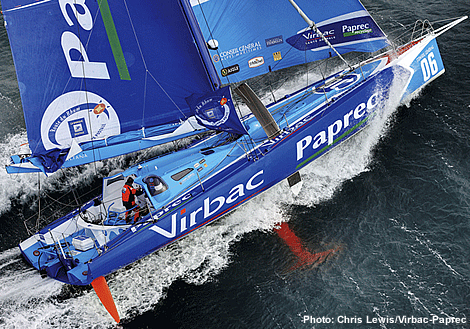
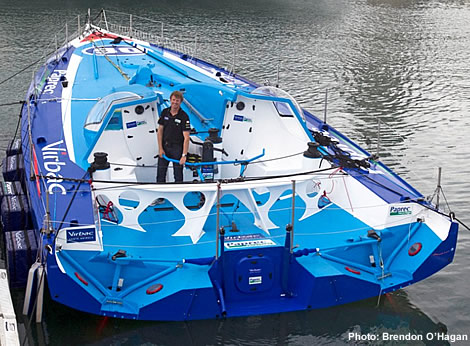
The most evident change with Paprec-Virbac 3 are her twin Hugo Boss-style doghouses, featuring large plexiglass screens to see forwards, and between them all the lines running aft from the mast, dispensing with the tunnel through the coachroof that we saw on all the previous generation designs. Her mast is also a departure, being a classic fixed rig, only that it has two rather than three spreaders - a piece of fine engineering by Southern Spars, the end result being light and low windage. The boat also features the curved ORMA 60-style daggerboards.
Which brings us back to the new Foncia. Details of the new boats are vague only that the hull is different again with more beam than the first generation VPLP-Verdier designs and with some tumblehome (harking back to the Joubert-Nivelt designs Open 60s of a decade or more ago). “It is weight saving for the deck and to optimise the stability,” says Lauriot Prevost of this latter aspect.
However the particularly radical feature already evident from photos is the unusual double camber to the deck which apparently allows all the chainplates and reinforcement in the deck to be lower, once again reducing the CoG. More will become apparent when the new Foncia is launched next month.
The program for Desjoyeaux’s new boat is ambitious. Like Jean-Pierre Dick’s Virbac-Paprec 3, Foncia this autumn is competing in both the Route du Rhum, an event Desjoyeaux has previously won in his ORMA 60 trimaran, and then the boat is being hurriedly shipped to Spain to compete in the Barcelona World Race, which Desjoyeaux is sailing with young Figaro sailor Francois Gabart.
“I am confident in this choice but I think also that we will have enough experience and enough youthfulness together,” says Desjoyeaux of his Barcelona World Race co-skippper.
In general it sounds like the latest IMOCA 60s are going to be even more uncomfortable than the previous generation with the interiors stripped bare and no headroom thanks to the smaller cabintops overhead and the water ballast tanks under foot. However the Route du Rhum in the IMOCA 60 class is lining up to be a fine inter-VPLP-Verdier contest between the three new boats and the two old ones.
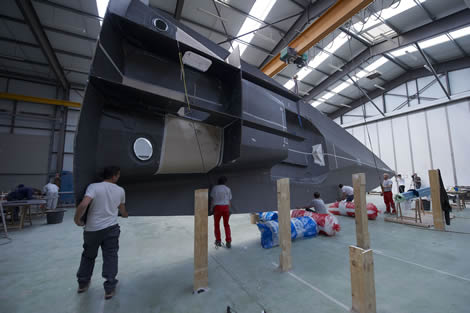
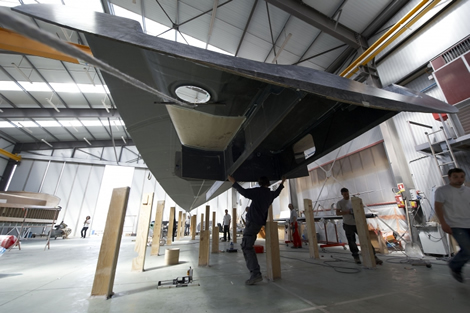
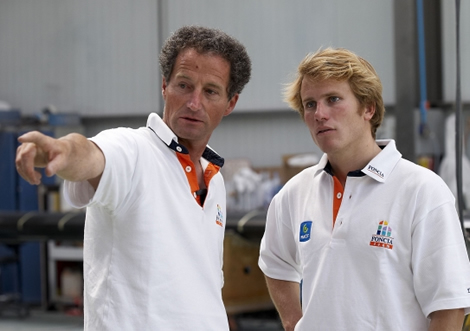
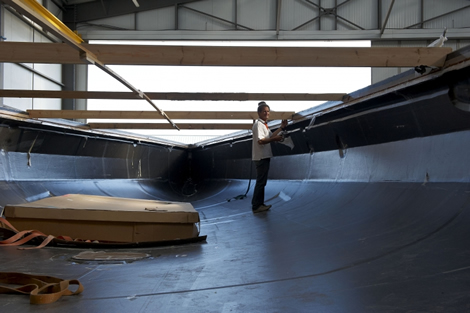

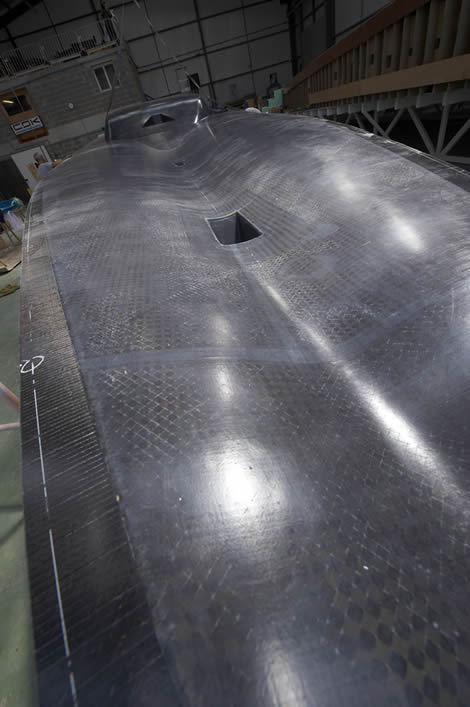
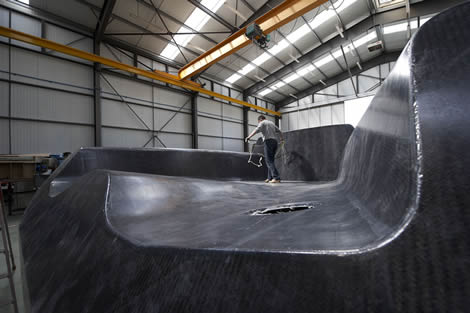








Latest Comments
Add a comment - Members log in